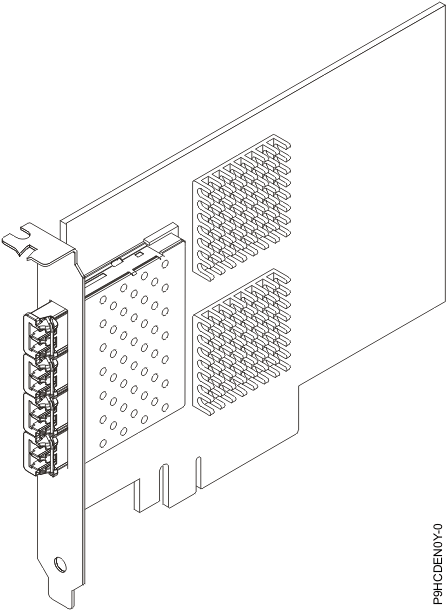PCIe2 LP 8 Gb 4-port Fibre Channel Adapter (FC EN0Y; CCIN EN0Y)
Learn about the specifications and operating system requirements for the feature code (FC) EN0Y adapter.
Overview
The PCIe2 LP 8 Gb 4-port Fibre Channel Adapter is a PCI Express (PCIe) generation-2, low-profile, high-performance, x8 short form factor plus (SFF+) Host Bus Adapter (HBA). This adapter enables multiple logical (virtual) connections to share the same physical port. Each logical connection has its own resources and the ability to be managed independently. Each port provides single initiator capability over a fiber link or provides multiple initiator capability with N_Port ID Virtualization (NPIV). The ports are connected by using mini little connectors (mini-LC) type connectors. These connectors use shortwave laser optics. The adapter operates at link speeds of 2, 4, and 8 gigabits per second (Gbps) and automatically negotiates to the highest speed possible. LEDs on each port provide information about the connection status and link speed of the port. The adapter connects to a Fibre Channel switch.

| Hardware State | Yellow LED (8 Gbps) | Green LED (4 Gbps) | Amber LED (2 Gbps) | Comments |
|---|---|---|---|---|
| Power Off | Off | Off | Off | |
| Power On (before firmware initialization) | On | On | On | |
| Power On (after firmware initialization) | Flash | Flash | Flash | All flash at the same time. |
| Firmware Fault | Flash in sequence | Flash in sequence | Flash in sequence | Flashing in sequence of yellow LED, green LED, amber LED, then back to yellow LED. |
| 2 Gbps Link UP/ACT | Off | Off | On/Flash | On for link up and flash if I/O activity. |
| 4 Gbps Link UP/ACT | Off | On/Flash | Off | |
| 8 Gbps Link UP/ACT | On/Flash | Off | Off | |
| Beacon | Flash | Off | Flash | All flashing at the same time. |
Specifications
- Item
- Description
- Adapter FRU number
- 74Y3923
- Wrap plug FRU number
- 12R9314Note: The wrap plug is included with the card, and can also be purchased from IBM®.
- I/O bus architecture
- PCIe2.0 x8
- Slot requirement
- For details about slot priorities, maximums, and placement rules, see PCIe adapter placement rules and slot priorities and select the system you are working on.
- Voltage
- 3.3 V and 12.0 V
- Form factor
- Short, low-profile
- Cables
- For information about the cables, see Cables
- Attributes provided
- NPIV capability is supported through VIOS.
- Requires a PCI Express generation-2 x8 slot for all four ports to operate at full speed.
Cables
- OM3: Multimode 50/125 micron fiber, 2000 MHz x km bandwidth
- OM2: Multimode 50/125 micron fiber, 500 MHz x km bandwidth
- OM1: Multimode 62.5/125 micron fiber, 200 MHz x km bandwidth
| Header | Cable Type and Distance | ||
|---|---|---|---|
| Rate | OM1 | OM2 | OM3 |
| 2.125 Gbps | 0.5 meters to 150 meters (1.64 feet to 492.12 feet) | 0.5 meters to 300 meters (1.64 feet to 984.25 feet) | 0.5 meters to 500 meters (1.64 feet to 1640.41 feet) |
| 4.25 Gbps | 0.5 meters to 70 meters (1.64 feet to 229.65 feet) | 0.5 meters to 150 meters (1.64 feet to 492.12 feet) | 0.5 meters to 380 meters (1.64 feet to 1246.71 feet) |
| 8.5 Gbps | 0.5 meters to 21 meters (1.64 feet to 68.89 feet) | 0.5 meters to 50 meters (1.64 feet to 164.04 feet) | 0.5 meters to 150 meters (1.64 feet to 492.12 feet) |
Operating system or partition requirements
- The latest version of enabling libraries and utilities can be downloaded from the Fix Central website.
- Power Systems Prerequisites website.
- IBM System Storage Interoperation Center (SSIC) website.
- The latest version of the device driver or IBM Power® RAID adapter utilities (iprutils) can be downloaded from the IBM Service and Productivity Tools website.
- For information about important notices for Linux on IBM Power Systems, see the Linux® on IBM website.